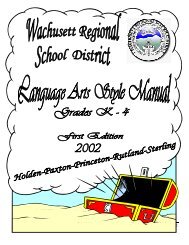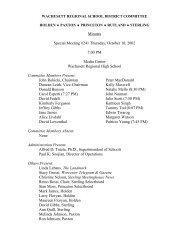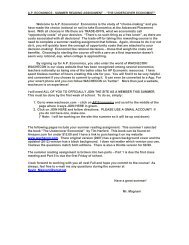(MCAS) ELA Grade 4
(MCAS) ELA Grade 4
(MCAS) ELA Grade 4
Create successful ePaper yourself
Turn your PDF publications into a flip-book with our unique Google optimized e-Paper software.
English Language Arts<br />
5<br />
6<br />
7<br />
8<br />
The ancient Egyptians made mummies because they believed that all living things<br />
consisted of two parts: the body and the spirit. Life ceased when the spirit left the body,<br />
and in order for someone to be reborn in the afterlife, spirit and body had to be reunited.<br />
If the body was destroyed before the spirit came back from its judgment, there couldn’t<br />
be a rebirth. Animals were preserved not only because they were sacred, but also to provide<br />
companionship in the afterlife. Including both people and animals, some experts<br />
have estimated that several million bodies were turned into mummies. So, what would it<br />
matter if a few hundred were taken away by collectors<br />
Mummies were valued for a more important reason than collecting: people believed<br />
that the powder from ground-up mummies was a valuable medicine. It was used to treat<br />
headaches, coughs, skin rashes, nausea, ulcers, and other ailments. Supposedly, it was<br />
the resin and oils used in embalming that were beneficial. Mummies were also believed<br />
to contain bitumen, an oily tar people thought was medicinal. As it turns out, bitumen<br />
was never used for wrapping. However, the Arabic word for bitumen—mumiyah—is<br />
where we get the word mummy.<br />
Medicine was not the only unusual use for mummies. In 1859, an Egyptian farmer<br />
was plowing his field when he discovered a gigantic cat cemetery. A total of 300,000 cat<br />
mummies were removed from the site, many of them in such poor condition that they<br />
crumbled when touched. Most of them were shipped to England to be used—believe it<br />
or not—for fertilizer. . . .<br />
Only relatively recently have authorities taken measures to preserve Egypt’s national<br />
treasures from further destruction and deterioration. However, even though so many<br />
mummies have been lost forever, those remaining can still teach us much about life—and death—<br />
in ancient Egypt.<br />
THE MASSACHUSETTS COMPREHENSIVE ASSESSMENT SYSTEM: 63<br />
Release of Spring 2000, 2001 & 2002 Test Items<br />
Rev. 06/03 srm
















